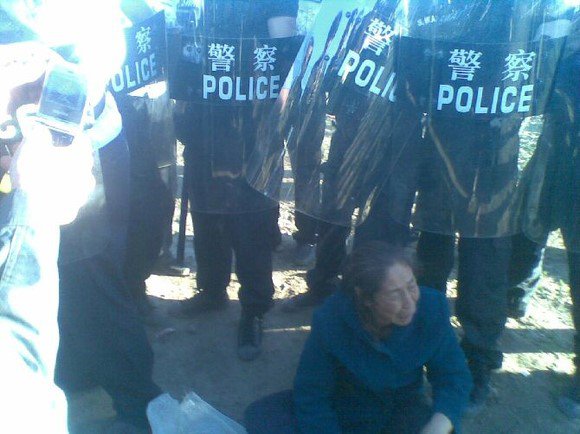| Radio Free Asia |
| August 25, 2011 |
| Washington DC |
 |
|
Ethnic Mongolians say that China's exploitation of grasslands is behind a wave of social unrest.
China's government
and official media
have warned of
large-scale
ecological
destruction of
grasslands,
including those in
the troubled
northern region of
Inner Mongolia—a
factor some say was
behind recent
protests in the
region.
"The state of the
grasslands should be
monitored on an
annual basis and a
comprehensive survey
of grassland
resources should be
conducted every five
years," official
media cited a recent
directive from
China's cabinet, the
State Council, as
saying.
"Practices of
illegal use and
exploitation of
grassland resources
should be
investigated and
punished in
accordance with the
law," it said.
Experts say that
deep-seated cultural
ties to the
grasslands and
traditional nomadic
ways of life lay
behind a wave of
protests that swept
across Inner
Mongolia in May.
Ethnic Mongolians,
who make up almost
20 percent of Inner
Mongolia's 23
million population,
complain of
destruction and
unfair development
policies in the
region, which is
China's largest
producer of coal.
The overwhelming
majority of the
residents are Han
Chinese.
Ninety percent of
China's 400 million
hectares (988
million acres) of
grassland now show
some degree of
environmental
degradation,
according to vice
minister of
agriculture Gao
Hongbin.
Gao was recently
quoted in official
media as saying that
the preservation of
China's grassland is
an "extremely
pressing task."
Beijing recently
rolled out a slew of
tax breaks and
funding for
enterprises in rural
areas that implement
environmentally
friendly programs
and technological
innovations in the
field.
"The government will
also provide
subsidies for cattle
herders in northern
and western China,
as these herders
will be prohibited
from allowing their
cattle to graze on
severely damaged
grasslands," the
official China
Daily newspaper
reported.
Indigenous rights
But overseas rights
campaigners said
that Chinese
authorities are
still a long way
from protecting the
rights of indigenous
nomadic people, who
have roamed China's
grasslands for
centuries.
"They are still not
listening to the
indigenous peoples
who have true
knowledge and
experience of taking
care of grassland,
but are determined
to continue to bar
the herders from
returning to their
grasslands," said
Enhebatu Togochog,
director of the
U.S.-based Southern
Mongolian Human
Rights Information
Center (SMHRIC).
He said Chinese
authorities continue
to exploit the
grassland in spite
of slogans like
"grassland
protection" and
"economic growth."
"Not only will these
policies bring
disastrous
ecological
consequences to the
grassland, but also
they will create
deeper social and
political problems
[for] China," he
said by e-mail.
"The May protest by
the Mongolian
herders and students
is an example."
Mongolian
protests
While the protests
were sparked by the
death of a herdsman
from the Shiliin-Gol
(in Chinese, Xilin
Meng) area, many
commentators believe
they reflect a deep
and widespread anger
over continuing
exploitation of the
region's grasslands,
the heartland of
Mongol culture.
Environmentalists
point to large-scale
environmental
destruction in Inner
Mongolian regions
where mining is
taking place, as
well as to more
subtle ecological
pressures in other
areas.
Open-cast, or strip,
mining is one of the
most environmentally
destructive forms of
mining, destroying
the surface
ecosystem over a
wide area and
releasing pollutants
into the air.
Last week, in one of
the latest examples
of unrest in the
region, hundreds of
local residents from
the Morin Dawa Daur
Autonomous Banner
near Hulun Buir city
have been protesting
against local
officials for
pressuring them into
signing over 1,385
mu (228 acres) of
farmland for
industrial
development.
They say the
government promised
them 2,200 yuan
(U.S. $345) per mu,
but the compensation
never materialized.
In May, Chinese
authorities poured
armed police and
security forces into
Inner Mongolia to
contain protests
sparked by the death
of a herdsman,
Murgen, who was run
over during clashes
with mine company
trucks.
The mine worker who
was convicted of the
killing was executed
last week, according
to a report by the
official Xinhua news
agency.
Thousands of
students were locked
in campuses at major
schools, colleges,
and universities in
the regional
capital, Hohhot.
The Hohhot clampdown
followed
demonstrations by
hundreds of ethnic
minority Mongolians
who called for
better rights
protection for
Mongolians and the
release of
detainees.
The U.S.-based
SMHRIC said an
estimated 40 people
were detained since
major protests
erupted in
Shiliingol League in
May.
Official media have
responded by saying
SMHRIC has few
connections to the
region.
Reported by Luisetta
Mudie and by Pan
Jiaqing for RFA's
Cantonese service.







